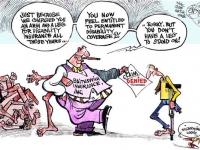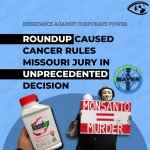Bad Faith: Fraud in the Insurance Industry

Joan Hangarter had everything going for her. She had a successful chiropractic practice, two great kids, a nice house in upscale and comfortable in Marin County, California, a late-model car, and a relationship she saw as solid and lasting. Then one day in 1997, while she was performing a difficult lumbar manipulation on a patient, Joan felt a sudden ripping pain in her right forearm. The pain radiated up the arm to the base of her neck.
Joan tried visiting fellow chiropractors. These health practitioners use physical methods (such as applying force with their hands) to adjust the spines of their patients manually in an effort to prevent and treat health problems. She also went to physical therapy twice a week for two months. "They worked on my neck and also on my arm," she said. "And it was brutal. They'd go in and rub the arm and stretch it. But it didn't do any good. It got worse."
Despite this, Joan continued working. She didn't want to let her patients down, and she didn't want to lose them. Sometimes she wore a shoulder brace, but the pain persisted. If she was inactive, it was deep and nagging. During manipulations, it would become very sharp and, as Joan described it, stabbing. "Sometimes," she said, "it would feel like [the] muscle was coming off the bone. Like it was ripping. With tremendous amounts of burning in my upper scapula, in my neck." Following extensive testing, her doctors told her that her injuries were permanent and that she would no longer be able to perform the demanding maneuvers required in her work. She was devastated.
In July 1997, she filed a disability claim with Paul Revere Life Insurance Company. She filled out stacks of forms, signed medical and financial releases, and answered a battery of questions from company claims officials. After a standard investigation, Paul Revere approved the claim. Joan would receive benefit payments of $8,100 a month.
But Paul Revere was, itself, not in the best of health for reasons that most of its members knew nothing about.
To understand why, one has to delve into how the insurance industry works. Insurance companies don't make profits directly from the money they get from the monthly payments (premiums) paid in by claimholders. No, their cashflow comes from their financial investments. The companies earned their profits by accumulating money from their membership, which in turn they invested in the markets. In the 1980s, a decade of double-digit interest rates and bond returns, it was hard to lose at this game. And with its high premiums, long-term policies, low marketing costs, and limited risk, there was no better source for this money than the disability policies.
This was the time to rake it in, the time to corner the market. All you had to do was come up with a seductive benefits package, price premiums aggressively, hire swarms of hungry sales agents, put them on high commission schedules, and stand back. The premium dollars would fly in, the cash would be thrown into the bond market, and profits would soar. If the competition didn't match you, step for step, you would own them before they could walk out the door. The meek might inherit the earth, but before long, the bold would have it all back and would be disinheriting them.
In 1983, there were dozens of disability insurers in the business but only three heavyweights: Provident Life and Accident Insurance Company of Chattanooga, Tennessee; the Paul Revere Life Insurance Company of Worcester, Massachusetts; and Unum Life Insurance Company of America of Portland, Maine. Whether through loose lips, competitive surveillance, or coincidental stupidity, all three companies came up with similar plans. Between 1983 and 1989, Provident, Paul Revere, and Unum had nearly a 100,000 agents from Maine to California and throughout Canada selling "own-occupation" (own-occ) individual disability insurance. These policies held the enticing promise of payment should the insured become unable to perform the duties of his or her "own occupation." The pitches were almost identical:
- Buy ours; it's non-cancelable.
- No, buy ours; the premiums can never be raised.
- No, buy ours; it will pay benefits for life, not just to age sixty-five.
- Wait; we'll throw in annual cost-of-living adjustments to cover inflation.
Each company played on fear. The promotional material contained shocking statistics on the number of people seriously injured every year. This was accompanied by dire warnings about what could happen to someone who can no longer work. Auto accidents, sports injuries, illnesses, diseases - the litany of potential calamities went on and on.
Policy after policy was sold. Happy projections came into the boardrooms. Double-digit interest rates - so good for insurance companies, so bad for house buyers - would continue into the foreseeable future. Premiums were priced accordingly and could not be raised. Of course, claims would be made on these policies - people would be injured or would develop covered illnesses - but claims payments would be far surpassed by the fat investment revenues. Profits were just sitting there, waiting to be plucked, like juicy, fat little plums in a vast, glorious orchard that stretched from sea to shining sea - plums worth billions of dollars. As long as the interest rate projections that formed the basis for all of this continued to be correct, the profits would fly along as expected. The problem was the projections were wrong.
In the early 1990s, Paul Revere hit the low-interest wall and in 1997, it was taken over by Provident. On first analysis, Provident was faced with a seemingly unsolvable conundrum. On one hand, there was nothing the company could do about low interest rates, while on the other, it was receiving more and more long-term claims, like Hangarter's every day.
There are certain rules governing the insurance industry. One is the implied promise of good faith and fair dealing. This means that an insurance provider cannot unfairly deny a policyholder the peace of mind that he or she pays for when buying a policy. It is illegal for an insurance company to unreasonably delay, terminate, or reject a valid claim. Investigations of a claim must be full, fair, and objective. The company's financial interests must never, ever be put above those of the policyholder. The insurer may never conceal benefits - which wouldn't be hard considering that most policies read as if they were written in random Chinese. Any ambiguities in coverage must be read in favor of the claimant.
All of this means the company has to pay up honestly on legitimate claims. The "legitimate" part is what Provident decided to use to its advantage. After all, the insurer got to decide what a "legitimate" claim was. If the claimant disagreed, he or she could just sue the multibillion dollar company with its battery of in-house lawyers and army of high-priced outside counsel.
Provident's new CEO, J. Harold Chandler, tapped Ralph Mohney to take over Provident's entire claims department. With a background in accounting and tax, Mohney had never handled a single insurance claim in his life. But he, like Chandler, was a numbers cruncher. Outside consultants were hired, the situation was analyzed, strategy sessions were conducted, and the problem was examined from every angle. Through it all, one fact was certain. There were two sides of the equation - interest rates and claims. No matter what, one side was in granite - Provident could do absolutely nothing about the low interest rates. The other side, the claims side, was another matter entirely. It was there that changes could be made - bold, aggressive changes, amounting to a new corporate philosophy.
Starting in 1994 Chandler and Mohney instituted a number of "initiatives." The claims department began aggressively searching for reasons not to pay claims. Methods and strategies would be deployed. Obstructions would be raised, delays instituted, and medical determinations challenged.
The resulting profitability enabled Provident to consume its former rival, Paul Revere. By 1999 it would gobble up Unum, as well.
This was much to the misfortune of Joan Hangarter and many others who found their lives destroyed and themselves falling down the rabbit hole.
In March 1999, Joan was going to be dealing with Chandler's Provident, which called for an independent medical examination (IME) even though Paul Revere had already evaluated Joan's claim and had been paying benefits. The examining doctor in an IME is handpicked by the insurance company; in this case, Provident picked Dr. Aubrey Swartz, an orthopedist. Dr. Swartz was charged with examining Joan, writing a report, and forwarding his conclusions to Provident's claims department. Dr. Swartz said nothing to Joan following the examination, and Joan assumed his report would confirm her injuries and disabilities.
A month later, after consulting with her own doctors, Joan realized her condition was permanent. She would not be recuperating. She would never again be able to return to chiropractic work. Even though the practice had limited value without Joan's involvement, she had no choice but to sell it.
A few weeks later, Joan had a visitor: claims representative Ken Seaman. Provident, Seaman said, after reviewing Dr. Swartz's report, had decided that Joan could perform her professional duties after all. Her benefits would be terminated immediately. Joan was stunned.
"There must be some mistake," she protested. "I've tried and tried. There's no way I can do the work." Seaman was adamant. Joan's benefits were being cut off. Couldn't Provident at least pay some benefits while she learned to do something else? Joan pleaded. Seaman was firm. The answer was no. There was nothing he could do. "But I've sold my practice. I have no money. I have two children. Can't you do something?" Seaman shook his head. The decision had been made. Joan was to get no reprieve.
On May 21, 1999, Provident sent her a termination letter, signed by Joseph Sullivan, a claims representative. Quoting from the policy, the letter told Joan she wasn't qualified for benefits under either the total disability or the residual (partial) disability provisions. She was not, said the letter, disabled. Provident based its decision, it explained, on the wording of its policy, the facts of her case, and the results of its IME report. Joan had received her last check.
With her safety net yanked from under her, Joan's life spiraled downward. The sale of her business fell through, Joan and her partner were evicted from the house they were intending to buy, losing their down payment, and Joan's personal property - furniture, clothes, everything - had to be put into storage. The relationship fell apart.
Practically broke, Joan piled her kids in the car and drove over five hundred miles to Encinitas, California. There she, as she put it, "camped out for weeks with the children" in her sister's tiny house. She tried to perform some part-time chiropractic work, but the pain was too excruciating. She searched for other job opportunities but was so despondent and frightened that she broke down in tears during an employment agency interview.
Then one afternoon while Joan was glancing down at her sister's kitchen table, she saw an article in the Wall Street Journal about a law firm that was accusing UnumProvident of fraudulently terminating the disability benefits of its insureds in order to boost profits. Until seeing this article, Joan had no idea that there might be anything she could do to fight Provident's actions.
She called, talked to my partner, Alice Wolfson, withstood a bombardment of tough questions about her medical condition and the facts of her case, and scheduled an appointment.
Oversight
Through it all, Provident refused to budge. It wouldn't pay her a dime. You might wonder how insurance company executives could believe they could get away with blithely refusing to live up to their company's policy provisions. What could they be thinking when making such decisions? How could they think they could get away with it? To answer this question, we need to examine the only three potential sources of oversight that exist to curtail any kind of corporate misconduct.
These are federal regulatory enforcement, state regulatory enforcement, and private regulatory enforcement.
As far as the insurance industry is concerned, the first option, federal regulatory enforcement, requires only a short discussion - very short. There is no federal regulatory enforcement. None. That's because there's nothing to enforce. There are no federal insurance regulations. How is it possible that the same federal government that oversees communications, banking, manufacturing, pharmaceuticals, energy, securities, interstate commerce, and practically everything else (from the use of dirty words on the radio to the permissible size of mud flaps on tractor-trailers) has not enacted a single antifraud law regulating insurance? Easy - it's all about lobbying.
In 1945, as a result of insurance industry "urging," in concert, undoubtedly, with the usual palm-greasing payoffs that have come to be known as "campaign contributions," Congress enacted the McCarran-Ferguson Act. This act actually prevented the federal government from enacting any insurance consumer protections at all. Today, believe it or not, out of the millions of pages of federal statutes, codes, guidelines, requirements, and standards, not a single provision, a single sentence, or a single word regulates insurance practices.
As a result, an insurance company can scam policyholders from Maine to California with false coverage promises, outrageous claims denials, and intimidating policy cancellations without the slightest concern that federal authorities might crack down on them. They won't. The only federal involvement with the subject of fraudulent insurance practices is that (to the extent that revenues are not filtered offshore) the government collects a chunk of the illegal profits in the form of taxes.
Many argue persuasively that, given the current composition of Congress, if this situation were to change today and the federal government were to suddenly become involved in insurance regulation, it would not be good for consumers. Any such "regulations" would wind up protecting insurance companies instead of safeguarding policyholders.
Well, what about the state governments? Most states have what are called "unfair insurance practices acts" - legislation making it illegal for insurance companies to:
- engage in unreasonable delay
- underpay, terminate, or deny valid claims
- put their financial interests above those of their policyholders
- conceal benefits from claimants
- interpret policy ambiguities against insureds
- use their superior size or wealth to intimidate or undersettle claims
- force policyholders to sue them in order to obtain benefits due
In addition, all states have insurance departments - agencies responsible for enforcing these and other provisions of the state's insurance regulations. So if all states have enacted insurance laws, what's the problem? The problem is that insurance code standards are the easy part. It's the remedies that complicate matters. There's not a single insurance department in America that has the authority to sue an insurance company on behalf of a cheated claimant.
What insurance departments do, as far as claims practices are concerned, is to investigate whether insurers doing business in the state are violating unfair-practice laws. These investigations are called "market conduct studies." If a study is conducted and if a company is found to be engaging in illegal practices, then in theory the company can be fined, but this rarely happens. And when it does, the fine is usually a complete joke.
But beyond the amount of the fine, the point is that these "investigations" do absolutely nothing to put even a dime into the pockets of a defrauded policyholder who was cheated out of a few hundred thousand dollars by his or her friendly multinational insurance company.
It gets worse. State insurance commissioners are the ones who run the nation's state insurance departments. These commissioners basically make all the decisions in terms of what a given state does to enforce its regulations. Critics characterize these commissioners as revolving-door, pro-industry hacks, appointed (or elected, thanks to "campaign contributions" from insurance companies) based largely on their demonstrated ability to do exactly the opposite of what a watchdog regulator is supposed to do.
And even in states like California with relatively good commission, the departments of insurance (DOI) still can't recover money for cheated policyholders. DOI simply don't have that authority. For that, we must turn to option three - private enforcement. Now the subject really gets interesting. Private enforcement occurs when a cheated insured is able to file a civil damages lawsuit under his or her state's insurance regulations. Such a lawsuit is aimed at recovering damages caused by the fraudulent or bad-faith actions of the insurer.
For a lawsuit like this to be effective, the remedies provided to policyholders under state law must be effective. The problem is that in most states, such remedies are totally inadequate. Moreover, they differ from state to state, largely as a result fo the effectiveness of insurer lobbying. An individual from New York or Massachusetts who loses hundreds of thousands of dollars as a result of a wrongful claim denial has fewer rights, and far less leverage, than someone who suffered the same fate, for the same reason, in California.
ERISA
Unfortunately, insured people even in the "better" states are having those rights stripped away. Why? How? The ERISA preemption. ERISA preemption is intended to sound as boring as it does. If something is boring sounding, people probably won't pay attention to it. The less they pay attention, the easier it is to rob them blind. ERISA, an acronym for the Employee Retirement Income Security Act of 1974, is a federal law that was originally intended to protect the retirement benefits of employees against mergers, acquisitions, and other corporate activities that might otherwise have endangered such funds. ERISA originally had nothing to do with overruling state insurance regulations.
To the contrary, it specifically approved of the use of state laws to regulate insurance practices. That was until the U.S. Supreme Court, in a ruling written in 1987 by Justice Sandra Day O'Connor, changed all of that. In an opinion written in the case of Pilot Life v. Dedeaux, the nation's high court eliminated all of the legal rights - established over decades under state laws - to protect policyholders from fraudulent and bad-faith insurance practices.
The O'Connor ruling simply took a broom and swept these rights under the rug, out the door, down the hall, and into oblivion. Here's how it happened. Insurance companies couldn't stand the idea that their cheated customers could actually sue them. And so, in 1987, they took their cause to the U.S. Supreme Court. Help us, they said to the Court. If you take away the rights of policyholders to sue us under state laws - at least under policies of insurance purchased at the workplace - if you say that all of the state law protections of those insured are to be preempted (displaced) by federal law, then because there are no federal protections, we will be immunized from fraud. If you do this, said the carriers, at least as to these workplace-purchased policies, we will be able to lower premiums. This will, reasoned the Supreme Court, encourage the formation of employee benefit plans. Insurance will be more affordable and therefore more people will have it.
Just a second, said the opposition. You can't allow insurance companies to get away with cheating their own policyholders - stealing the very benefits they paid for. And even though an insurance company could increase profits by refusing to pay 5 or 10 percent of its valid claims, there would be no guarantee that they would pass on these illegal savings anyway. Besides, what about the people who would be losing their homes, their life savings, and everything else? The Supreme Court shouldn't be taking away their right to recover for such losses. You can't substitute federal insurance regulations for state insurance regulations. There are no federal regulations or deterrents. Too bad, ruled the high court. Henceforth, all consumer rights under state laws on employment-purchased insurance policies are "preempted" by ERISA. And because ERISA provides no remedies for misrepresentation, with a stroke of a pen, the Supreme Court left insurance consumers who had obtained their policies at work with no antifraud or bad-faith protections under either federal or state laws.
To this day, such policyholders have no rights to recover for losses caused by such practices. More importantly, a targeted policy holder has no leverage whatsoever to get his or her insurer to simply pay what it owes under its policy. With nothing to motivate them to pay ERISA claims fairly, many insurers simply don't. In fact, UnumProvident, in a highly confidential internal company memo that we got our hands on, actually bragged that it could save more than 95 percent of what it would otherwise have to pay if a claim was preempted by ERISA.
"Just a second," you may be saying. "It seems to me that ERISA preemption is inconsistent with McCarran-Ferguson. I thought the federal government was barred from regulating insurance? How is ERISA preemption consistent with that?" That is a very interesting question. Unfortunately, there is no logical answer. If you are ever given a choice between buying ERISA preempted insurance coverage through work versus non-ERISA preempted coverage through a group or individual policy purchased other than at work, the choice is easy. Don't ever buy a policy for which the insurance company, in cahoots with the U.S. Supreme Court, is immune from stealing from the insured.
Fortunately for Hangarter, she lived in California and she discovered her right to sue. My law firm was willing to take the case, and had not purchased her insurance under ERISA. Nonetheless, it took years of grueling and expensive litigation, while she survived on welfare and food stamps to win her case. And win it she did in February 2002 when a jury awarded her $7.67 million, including $5 million in punitive damages. Still, for another eight months she continued to live in poverty while UnumProvident, the nation's largest disability insurance firm, appealed the verdict.
On November 15, 2002, a judge ordered UnumProvident to "obey the law" and stop using biased medical examiners, withholding information about benefits from policyholders, and cancelling certain categories of claims.
After the judge's order to pay up, UnumProvident Senior Vice President J. Christopher Collins defended the company's practices. "We're the biggest target out there," he told the Los Angeles Times. "We have a third of the marketplace, and we've just become their favorite whipping post."
Bourhis is a partner with the San Francisco law firm Bourhis & Wolfson and was Hangarter's attorney in her suit against UnumProvident. The above article is adapted from Insult to Injury: Insurance, Fraud, and the Big Business of Bad Faith, Berret-Koehler Publishers Inc.
- 186 Financial Services, Insurance and Banking



